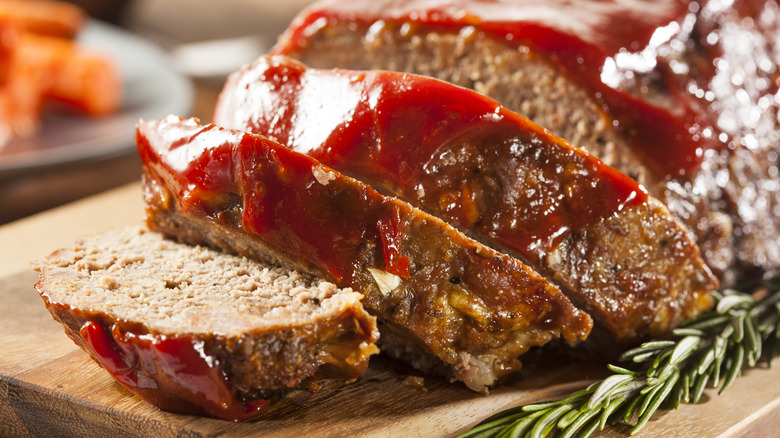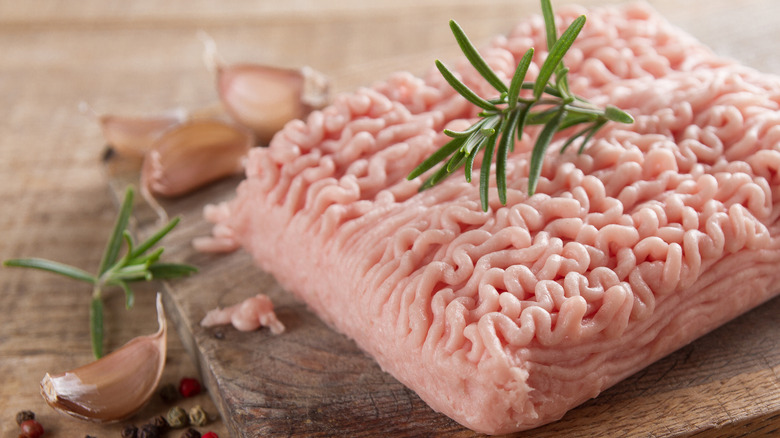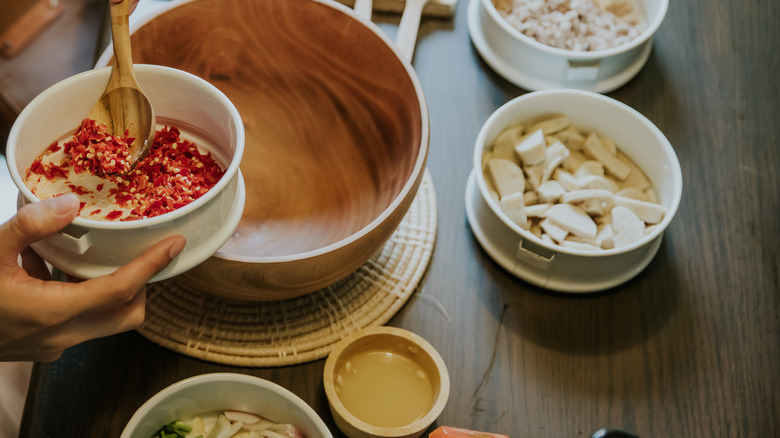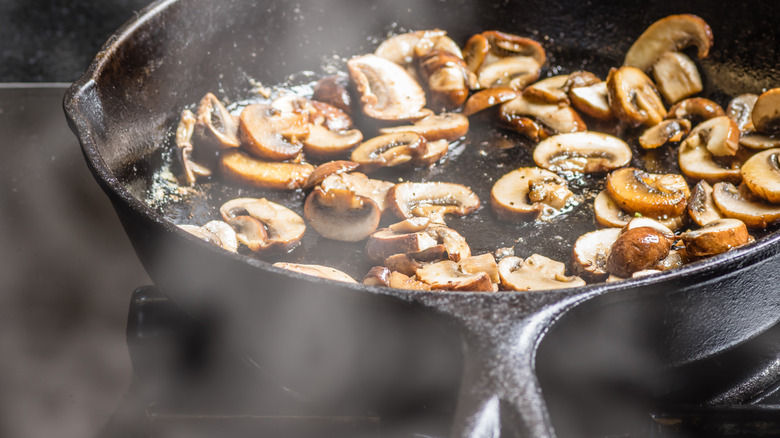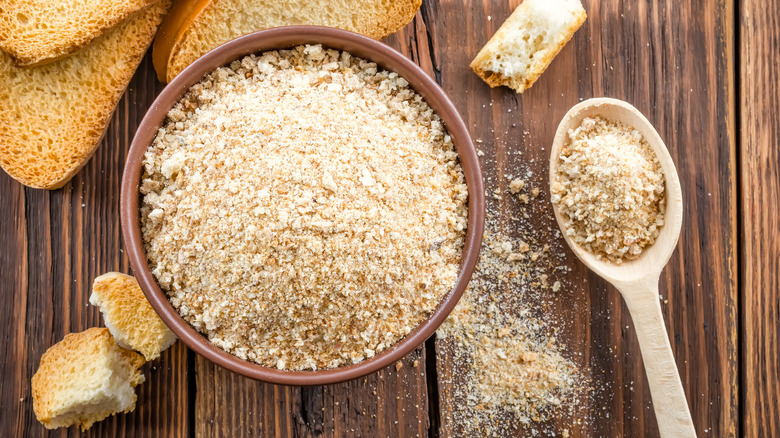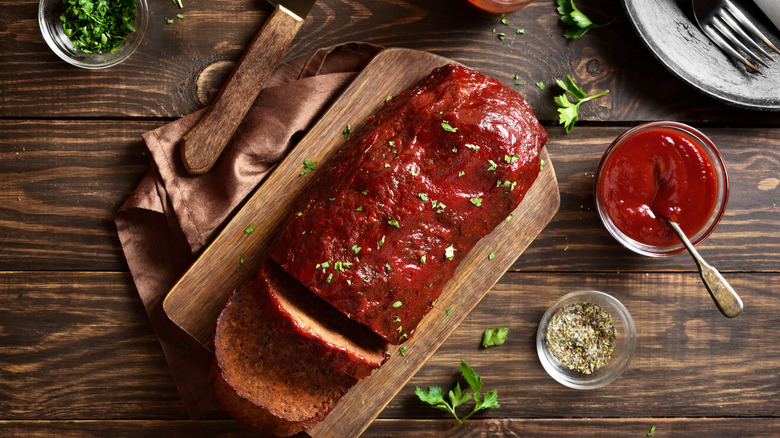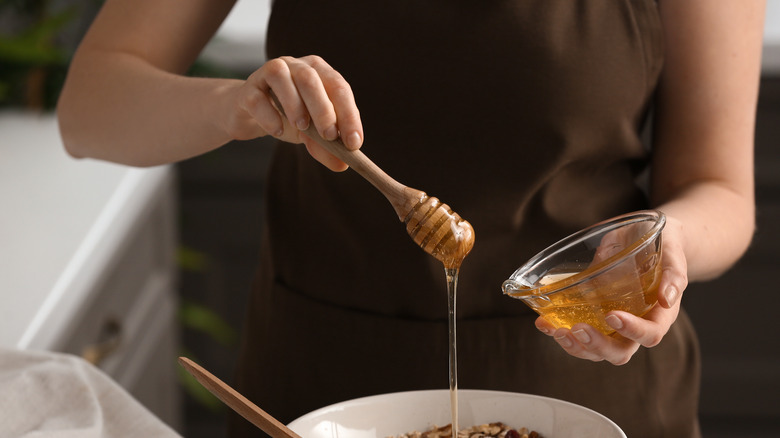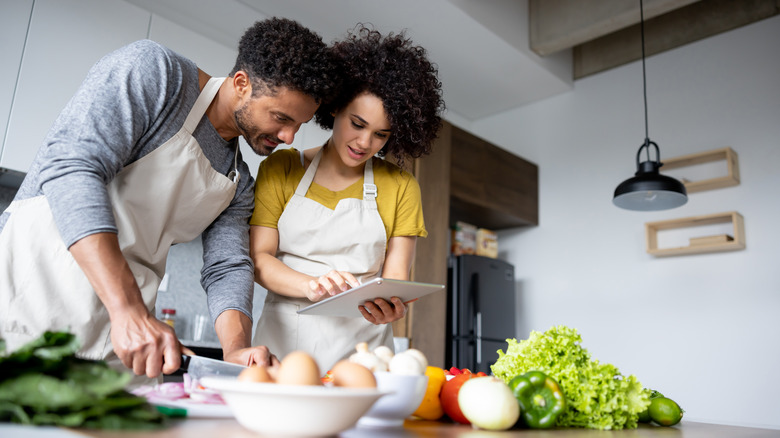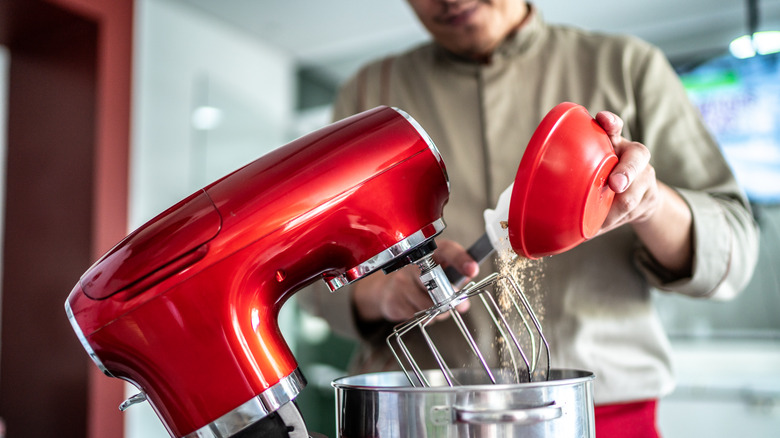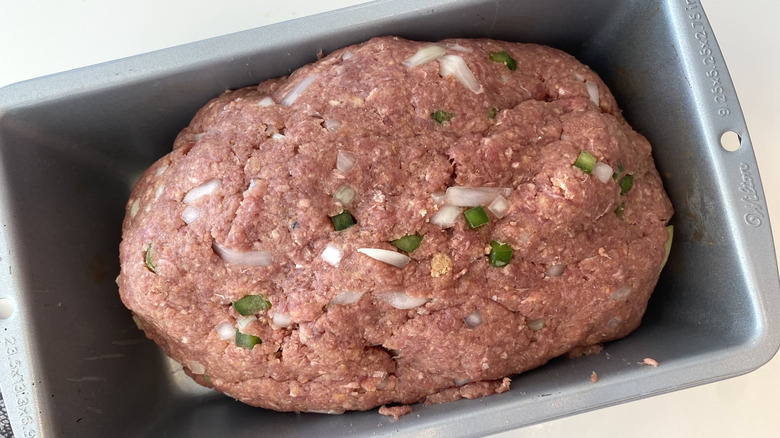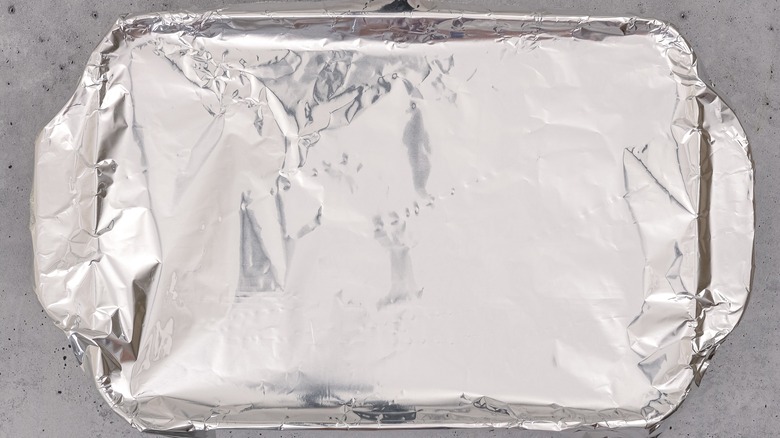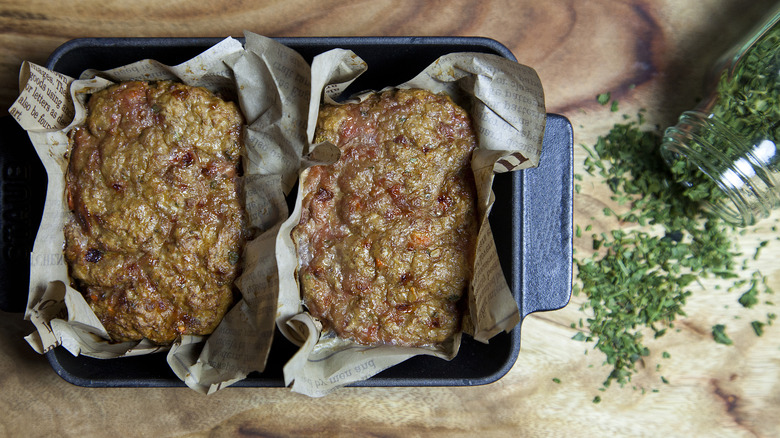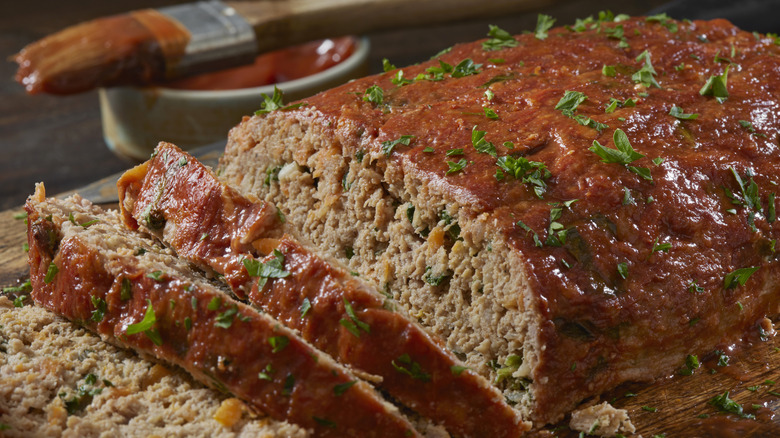The 15 Mistakes Keeping You From Perfect Meatloaf
Meatloaf is a great dish when executed properly. Not only is it considered one of the easier entrees to whip up in the kitchen, but it's also been a popular go-to meal for centuries and continues to be a budget-friendly option. You can use as little as a handful of ingredients for a classic meatloaf. But creative home chefs can also take this dish to the next level with just a few personal touches, veggie additions, or substitutions.
Of course, being able to put one's own spin on American comfort food often leads to something great and downright delicious, but sometimes it doesn't. The good news is there is more than one way to create a mouthwatering, hearty loaf that your family will love — as long as you know what to avoid. So whether you want to veer from the traditional meatloaf recipes slightly or stick to the basics, there are several things you can do to ensure you do not botch your dinner. That said, here are some of the most common mistakes keeping you from the perfect meatloaf.
1. Choosing leaner meat
You have some options for the type of meat you select for your meatloaf. From ground beef and turkey to sweet Italian sausage and meat alternatives, this recipe's main ingredient can be whatever you decide to make it. But if you are going with beef, the meat quality and overall fat content matter. After all, no one likes dry, boring meatloaf. Though it can be tempting to pick lean ground beef for meatloaf, you are sacrificing the overall taste when you go with a protein with less than 15% fat.
Another reason the fattier ground round is better for meatloaf is because the extra fat content helps the dish keep its shape. Therefore, ground beef with a fat content ranging from 20% to 30% is the best choice. Even if you opt for turkey or Italian sausage, you'll still want to aim for at least 15% fat. Alternatively, you can add olive oil to your vegetable base or use Beyond Meat, which typically has 14 grams of fat, for a tasty, crumble-free vegan or vegetarian loaf.
2. Overlooking how a different base changes the recipe
The meat or meat alternative you use for your loaf impacts the finished product. Even if you are craving some serious protein and want to make a three-meat meatloaf, you need to consider how adding multiple types of meat, such as veal, pork, and beef, will affect the other ingredients or the overall taste of your dish. This particular meat mix is usually available at grocery stores pre-made or upon request, so save yourself the trouble of figuring out the right or perfect ratio — just get the meat mix.
If you opt for a single meat that is not beef, on the other hand, then keep in mind that certain cuts might require more moisture, eggs, or meat. A common switch-up to the recipe when using ground chicken, for instance, is wrapping the loaf in bacon or mixing in higher-fat meats for a better consistency and flavor profile.
Similarly, veggie loaves need help from other veggies to ensure a yummy dish. Often, chickpeas can be a wonderful base for vegan meatloaf with the right additions, such as other vegetables (including carrots, celery, mushrooms, and onions), extra seasoning, and a tablespoon or two of olive oil. If you want multiple meats or a vegetable medley as your base, do your research to properly account for those changes when putting your loaf together — as guessing what to do next instead will likely not yield good results.
3. Assuming salt and pepper are all you need
Salt and pepper are the unmistakable power couple in the seasoning world and, of course, will help deepen the flavors of your meatloaf. But there are quite a few more spices and herbs you should consider adding to this dish. Garlic, mustard powder, Italian seasoning, red pepper flakes, and even dried thyme with rosemary are just a few cooking go-to's that can take your bland loaf to new heights. For turkey loaf lovers, a mixture of thyme and rosemary adds a robust and zesty flavor to an otherwise blander meat.
What's more, liquid smoke, Worcestershire sauce, and similar saucy additions only help to enhance the taste of your meatloaf. These sauces maximize the savoriness of common ground meat-based loaves (beef, chicken, or pork) and add aromatics reminiscent of mouthwatering barbecues everywhere. Other pantry gems like tomato paste and French onion soup mix infuse classic meatloaf with complexity and a hint of tanginess. Taco and southwestern seasonings are also options for jazzing up meatless meatloaf with bold, spicy, and refreshing flavors.
4. Adding raw vegetables to your meatloaf
There are a handful of veggies you can also add to your meatloaf, no matter what meat you use. For example, carrots, celery, bell peppers, mushrooms, zucchini, onions, and green onions are phenomenal additions to any kind of meatloaf. But you should never add raw vegetable to your meatloaf, because their crunchiness can ruin its texture.
As a result, sauteing your veggies is a must. Not only does cooking your mushrooms and other add-ins help to create a consistent texture, but it also allows the flavors to infuse with the other ingredients. Unless the recipe calls for you to put your vegetables in a food processor first, which is common for some renditions of meatless meatloaf, you should slightly cook your vegetables beforehand to avoid an overly chewy meatloaf with an uneven finish. Plus, dense or thick produce like carrots, celery, peppers, and onions is usually more malleable when sauteed.
5. Choosing the wrong binding agent
Choosing the wrong binding agent or using none at all is just one more example of the biggest meatloaf mistakes many home chefs make when perfecting their meatloaf recipe. But without an ingredient or two that keeps everything together, your presentation is just one of the many things that will suffer here. Binding agents like regular breadcrumbs, stuffing, crackers, and even oats are all great options, that also transform your hamburger in a pan into meatloaf.
Various recipes call for binding ingredients like rice, cornstarch, flaxseed, vegetable purees, and more, but you have to be careful when preparing your loaf with these. Once again, you may end up with a weird texture or an extremely dry meatloaf if you are not accustomed to using substitutes instead of the tried-and-true binding ingredients. It is worth noting that if you opt for conventional binders like breadcrumbs, crackers, and oats, you must soak them in milk or some other liquid before mixing all your ingredients together. Soaked binding agents are the secret weapons for moist, flavorful meatloaf.
6. Avoiding moist ingredients in your meatloaf
Avoiding wet ingredients is the quickest way to a less-than-desirable meatloaf. This is why you should consider using an extra egg, soaking your binding agent ahead of time, and opting for a base with a high-fat content. Adding vegetables that have been properly sauteed (ideally in butter or oil), finely chopped, or even pureed also yields a juicer loaf.
But that's not all you can do — as you should be adding moisture every step of the way when making meatloaf. You can use many different ingredients to help keep meatloaf moist, including a few tablespoons of ketchup, some tomato sauce, broth, water, soy sauce, or other liquid. Once you have assembled your loaf, brushing it with a light glaze will help to keep your dish nice and moist while it's cooking. And if you want a foolproof way to retain moisture, try Ina Garten's trick for ultra-moist meatloaf and place a steaming pan of water underneath the loaf.
7. Sticking to only savory flavors
Meatloaf is, almost by definition, a hearty and savory dish. But if you do not balance out the savoriness with some sweetness, then you are doing your loaf a disservice. Often, ketchup is added to meatloaf because it brings sweet, tangy, and bold flavors. You can add ketchup or barbecue sauce to the base of your meatloaf, as well as your glaze.
Other pantry staples like honey, maple syrup, and brown sugar are just as good here. If you are worried that these gems will overpower the savory components of your dish, however, you can just stick to adding them to your glaze. Sweet and spicy barbecue sauce, honey mustard, and infused maple syrup can all be used to coat your loaf and balance out the salty, umami undertones. Remember, savory and sweet are always the way to go when making a delicious, flavorful meatloaf.
8. Getting too creative with your additions and substitutions
Any cook will tell you that you can use an array of secret or special ingredients to improve your dish. But what one person thinks will be a great addition to the meatloaf may not be what everyone else expected. Moreover, if you are trying something for the first time, you might not be so pleasantly surprised with the result, which in turn makes dinner a non-starter.
Though there are a handful of unexpected ingredients that you can add to your meatloaf, like pesto, potato chips, and even cheese, you need to avoid going overboard — especially if you are unsure of how it will turn out. Likewise, if you are in a bind and need to get creative with a substitution, make sure to tread lightly. You may not always have everything you need, but you should not guess when it comes to substitutions. Find a recipe that works with what you have instead. And honestly, you truly do not need dozens of ingredients to create a meatloaf masterpiece.
9. Over-mixing your meatloaf ingredients
You may not want to get your hands dirty with the sheer number of dry, wet, and soaked ingredients in your loaf. But vigorously using a mixer of any kind or simply over-mixing your meat concoction will likely lead to some pretty tough meatloaf. The best way to combine all your meatloaf fixings is actually by hand, or rather, with your fingers. If you prefer to use a kitchen utensil or a standard spatula instead, you can — just make sure to lightly fold everything together when doing so.
Your mixer's paddle attachment can definitely do the job. However, it is important to use a low setting and keep a watchful eye on the mixing process. Similarly, using your hands is highly recommended for meatless or veggie meatloaf unless the recipe calls for a food processor. Overall, whatever your ingredients are, a quick and gentle mix is really all your meatloaf needs.
10. Forgetting to taste test your meatloaf
If you have decided to step outside the box with your meatloaf recipe, then you must taste test what you are cooking. Since your dish most likely has raw eggs and meat, you will need to cook a small portion of your mixture to taste it, which is easy enough. Once you have combined all your fixings, simply form a small patty or meatball and fry it.
Doing so will give you an idea of what your latest take on meatloaf tastes like. After sampling, add more seasoning to your mixture or make the necessary tweaks. This extra step may seem tedious, especially if you are not changing the recipe too much. But if perfection is the goal, do not forget to taste test. If everything is to your liking, shape your loaf and place it in a pre-greased pan off to the side while you create your glaze.
11. Opting for the wrong pan
There is a lot of debate surrounding which is the right pan for making meatloaf. Many people prefer to free-form their loaf and then cook it on a sheet pan to maximize the surface exposure, thus ensuring a crisp finish. The free-form shape will also encourage a flatter, more blob-like loaf. Some cooks use a loaf pan to keep their meatloaf moist and to give it the classic domed shape.
Though there tends to be a little more grease when the meatloaf is cooked in its designated pan, there is no denying that if you want your meatloaf cooked to the pinnacle of perfection, there is a pan for that. Still, if you do opt to freeform your loaf or use another piece of cookware, all hope is not lost — just be prepared for different yet arguably delicious results. Only you know how you like your meatloaf, so when considering a pan, choose wisely.
12. Baking the meatloaf covered
Yet another mistake keeping you from achieving the most glorious meatloaf is baking your dish covered. Foodies looking for the best of both worlds know that baking the loaf sans foil will allow for a crisp coating and firmer consistency. But if a slight crunch is not the goal, then you may choose to cover your meatloaf.
If you do want to cover your dish, then it is recommended that you do so only for the first leg of the baking time. Then, for the last 15 minutes or so, you can leave your meatloaf uncovered to finish it off and to achieve a nice coloring. Covering your loaf even for half the cooking time will result in a softer texture, which not everyone may enjoy. However, your meatloaf can still be a hit with the right ingredients and glaze, so how you bake it is really a matter of preference.
13. Cooking at the wrong temperature
Most traditional meatloaf recipes call for similar oven temperatures and cook times — and in general, the key to an amazing meatloaf is to bake it "low and slow." Yet, more often than not, people tend to overcook their prized loaves, ruining their otherwise polished entree dish. The truth is even if you do not exceed the cook time or get the oven temperature wrong, there is the potential for things to go awry. In order to prevent burning, drying out, or outright botching your meatloaf, keeping a watchful eye is a must.
Along those same lines, you should consider investing in a leave-in probe thermometer, especially if your oven has been known to bake things to an undesirable crisp. For home chefs doubling the ingredients or simply in a bit of a hurry to get dinner on the table, cooking your meatloaf at a higher oven temperature for a shorter time is possible — just be careful. It is also worth noting that if you make any variation of a meatless meatloaf, the recommended baking time is usually less than you might be used to. With that in mind, ensure your oven is at the right temperature according to your recipe, and always use your standard meat thermometer to check for doneness.
14. Super-sizing your meatloaf without a recipe
Part of the beauty of this comfort dish is that you can make it stretch without breaking the bank. And if you have found the perfect recipe for your needs, it can be very tempting to double it. Maybe you are feeding a large group or planning to freeze some for later — whatever the reason for making more loaf than you need, do not go at it blindly.
The internet is full of cooking directions. Thus, if you are contemplating super-sizing your meatloaf, find a recipe that has already figured out the best route for making twice as much of the good stuff. The same is true if you want to whip up a couple of individual or mini loaves. You cannot just double or change certain ingredients without running the risk of ruining your dish, and no one wants that, so plan accordingly.
15. Serving your meatloaf too early
With all of your hard work here, the last thing you want to do is botch the finished product by serving it immediately. Remember, once your meatloaf is done baking, you still have some work to do. To start, much like any other baked dish, you should always let the meatloaf rest after removing it from the oven. So, allocate enough time for your meaty masterpiece to cool off before taking it out of the pan.
After allowing your loaf to rest for about 10 to 15 minutes, drain any excess liquid off and transfer your main dish to a clean plate or cutting board. Next, slice up your meatloaf into relatively thin slices. You can add more glaze before or after slicing if you so choose. Either way, at this point, all there is left to do is plate and pair your perfected meatloaf with a few tasty side dishes and enjoy.
